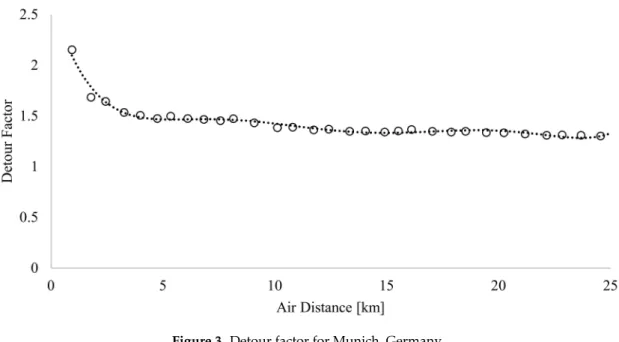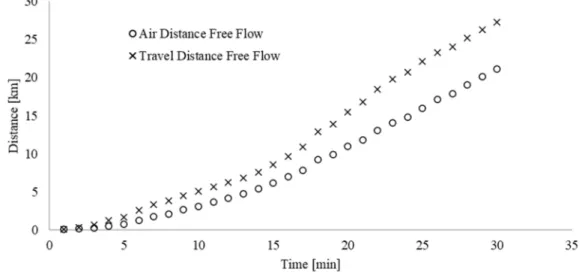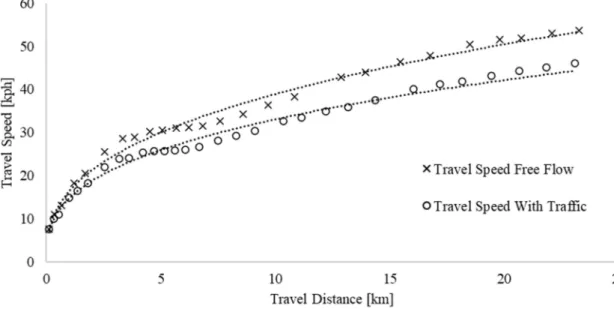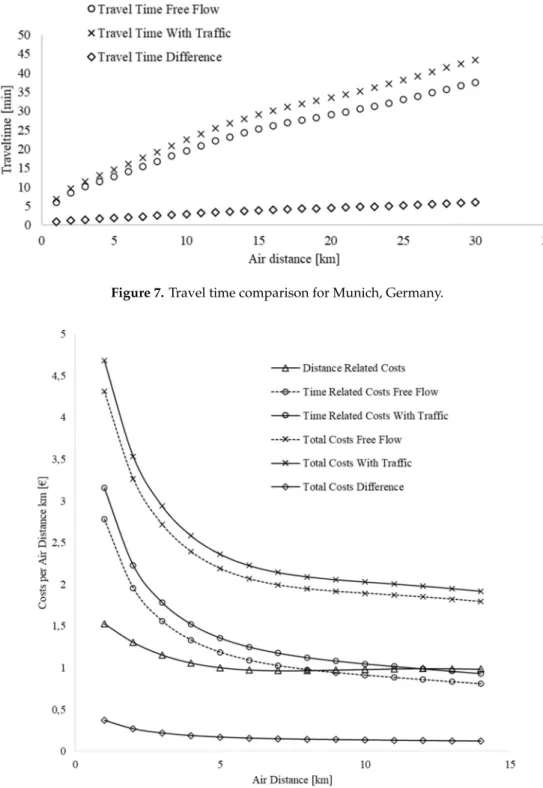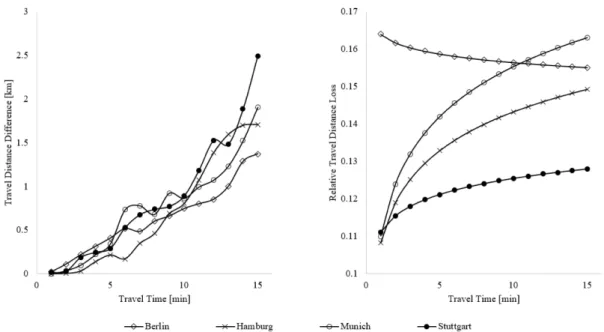Article
Towards Sustainable Cities: Utilizing Floating Car Data to Support Location-Based Road Network Performance Measurements
Maximilian Braun * , Jan Kunkler and Florian Kellner
Faculty of Business, Economics and Management Information Systems, University of Regensburg, Universitätsstraße 31, 93053 Regensburg, Germany; jan.kunkler@ur.de (J.K.); florian.kellner@ur.de (F.K.)
* Correspondence: maximilian.braun@ur.de; Tel.:
+49-941-943-2689Received: 25 August 2020; Accepted: 28 September 2020; Published: 2 October 2020
Abstract: Road network performance (RNP) is a key element for urban sustainability as it has a significant impact on economy, environment, and society. Poor RNP can lead to traffic congestion, which can lead to higher transportation costs, more pollution and health issues regarding the urban population. To evaluate the effects of the RNP, the involved stakeholders need a real-world data base to work with. This paper develops a data collection approach to enable location-based RNP analysis using publicly available traffic information. Therefore, we use reachable range requests implemented by navigation service providers to retrieve travel times, travel speeds, and traffic conditions. To demonstrate the practicability of the proposed methodology, a comparison of four German cities is made, considering the network characteristics with respect to detours, infrastructure, and traffic congestion. The results are combined with cost rates to compare the economical dimension of sustainability of the chosen cities. Our results show that digitization eases the assessment of traffic data and that a combination of several indicators must be considered depending on the relevant sustainability dimension decisions are made from.
Keywords: road network performance; urban sustainability; economic sustainability;
traffic congestion; data collection methods; navigation services
1. Introduction
Rising urbanization around the globe leads to high requirements in terms of urban sustainability [1].
Therefore, indicators to measure urban sustainability are an extensively discussed topic in literature [2–5].
These indicators often contain terms such as “mobility” [6], “efficient transportation”, or “transportation and roads” [7]. When dealing with the sustainability of transportation and the efficient movement of people and goods, in addition to topics such as railways [8] and public transportation [9–13], the urban road network is a major research area [14–20]. This stems from the fact that road network performance (RNP) can lead to significant negative impacts on all three dimensions of urban sustainability.
Economic sustainability can suffer in several ways. Many authors found that poor RNP, in terms of traffic congestion, is a reason for higher costs and reduces efficiency significantly [21–26].
In addition to that, traffic congestion intensified in the past [27,28], causing as much as 23 percent of all truck transportation delays [29].
Environmental sustainability is mainly focused on pollution and greenhouse gas emissions. A lot of literature proves the relation between traffic congestion and air pollution [30–34]. Longer travel distances and congestion lead to more pollution and a lower level of sustainability.
Social sustainability focuses on the well-being of the population. Poor RNP can lead to several health issues. Traffic congestion implies a higher number of vehicles polluting engine noises on road.
Sustainability2020,12, 8145; doi:10.3390/su12198145 www.mdpi.com/journal/sustainability
The generated noise has a significant health impact [35,36] such as sleep disturbance and anxiety [37].
In addition to that, the number of accidents happening can depend on the road network [38–40].
RNP in general has been studied extensively over the years, employing different methods and geared towards different purposes [41–45]. Especially the relation between the three-dimensional urban sustainability (economy, environment, and society) and the road network has been addressed.
An extensive body of literature discusses the reduction in traffic congestion [46–48].
Russo and Comi [49] analyze the effects of logistics measures on the economy of the city, Baghestani et al., Armah et al., Borza et al. and Zhang et al. [32,50–52] deal with on-road emissions and Kleiziené et al., Ohiduzzaman et al. and Sirin [36,37,53] discuss vehicle noise reduction and the development of quieter pavements.
To carry out these analyses, all stakeholders who are dealing with road networks and urban sustainability must gather a real-world data base to work with. Therefore, the research hypothesis of this paper can be formulated as follows:
How can relevant data be collected programmatically to measure road network performance?
The long-term trend towards digitizing the environment, including the logistical infrastructure such as road networks and vehicles, fundamentally eases the programmatical assessment of information and gives way to study new data collection methods [54–57]. Due to this, the purpose of this paper is to develop a new methodological approach to gather relevant RNP data on an area-wide scale.
An exemplary application of the gathered data on the economic dimension is demonstrated on four selected cities in Germany to prove the usability of the proposed methodology. Thus, the paper deals with what Sun et al. [58] call the physical issues of RNP, i.e., we are concerned with the determination of travel times, travel speed, and traffic conditions.
The paper is organized as follows: Section 2 provides theoretical information on RNP measurement and the underlying data collection procedure. In Section 3, a data collection method for measuring RNP is presented by providing an exemplary use case. In Section 4, this methodology is applied to four German cities and a comparison of these cities is carried out. In Section 5, theoretical and practical implications are discussed. An outlook for further research is provided in Section 6, followed by a short conclusion highlighting the main takeaways of this paper.
2. Literature Review
2.1. Fundamentals on Road Network Performance Measurements
The assessment of RNP has been widely researched. We start by introducing our definition and will then give reference to the extant body of research. We suggest defining RNP generally as the network driven impact on sustainability. In the context of this paper, we particularly focus on the economic dimension, which leads to the refined definition of RNP as being the network driven economical costs of moving a vehicle from a specified origin to a specified destination using the road network. Although the definition is open, we confine our analysis to urban transportation, i.e., short distance traffic, sometimes called the last mile or urban cargo traffic [59,60]. The road network is defined as the set of roads that can be used by vehicles. Thus, our definition of RNP is geared towards the structural properties of the network that shapes the flows within the network and affects operational performance [61,62]. The definition acknowledges but excludes the analysis of further notions or indicators of network performance, such as levels of service, capacity, safety, smoothness of flow, reliability, vulnerability, accessibility, resource constraints, or travel time reliability [63], that, respectively, represent the functionality of the network for particular research goals. As our analysis is restricted to network driven costs only, it is confined to a share of the total cost only. The cost of moving a vehicle is determined by many factors such as vehicle type [64], toll [65] or fuel [66].
We restrict the analysis to those factors that are related to the road network. The definition of RNP
borrows in part from Santosa and Joewono [67] who measure RNP by speed and vehicle cost.
We suggest measuring RNP by detour and travel speed. Detour is defined as “road distance from origin to destination” over “aerial distance from origin to destination” [68]. Thus, detour represents widely discussed network attributes such as density [62] or connectivity [69]. Travel speed is defined as the average speed that can be driven from origin to destination considering vehicle and road constraints. Thus, travel speed summarizes road network attributes such as speed limits, traffic lights, or the level of congestion within the network [70–72]. Travel speed can be easily converted into travel time [73]. Thoen et al. [74] demonstrate that longer travel times lead to higher transportation costs, emphasizing the importance of determining travel times objectively.
Road distance is defined as the distance of a tour. A tour is defined as the network path a rational decision maker would choose to minimize the travel time from origin to destination. Thus, we assume an efficient use of existing road infrastructure and available traffic status information [75]. We suggest measuring RNP with reference to two factors only and thus depart from earlier approaches that suggest multi-criteria measurements such as Fancello et al. [42].
RNP results vary by tour since characteristics of the road network vary across space.
Ciscal-Terry et al. [76] called this the origin-destination-distribution problem. Thus, a meaningful RNP statement must be specific on how to select the locations that enter the analysis.
Fundamentally, RNP can be measured via three origin-destination settings. One is to measure across the complete network, i.e., from anywhere to anywhere. A second setting measures from defined origins to defined destinations [77], i.e., from somewhere to somewhere. We suggest following a third setting, given an origin, we do not specify a destination and then measure detour and travel speed for the origin-destination pair but specify the origin only and list all destinations that can be reached within a given range or time frame.
Since we focus on studying RNP for general cargo moving purposes, typical logistics service providers’ locations such as freight transport centers, logistic zones or urban consolidation centers represent meaningful origins. For a case-specific analysis, Alho A.R. et al. [78] find that declared data regarding bases might not be as accurate as inferred data, suggesting the identification of central network nodes via algorithms instead of relying on survey data to determine meaningful points of origin. Referring to Saedi et al. [63] our approach does not report RNP across the complete road network but well-defined partitions.
2.2. Road Network Data Collection: Developing A New Method
Data sources to compute RNP have been mentioned in recent literature but have never been an explicit focus of the research community. Some papers model the variability of RNP via a stochastic framework and compute journey time estimators [79]. Figliozzi [22] uses tour data reported in the literature to perform a sensitivity analysis on changes in travel time and tour characteristics.
The problem with this procedure is the availability of data as the current literature does not provide suitable or publicly available tour data for most areas around the world. Another way to gather road data is the usage of equipped single cars [80,81]. These cars are equipped with a range of sensors to record road data while driving. The extensive manpower and machinery required for this solution is multiplied as global coverage is attempted. Urban areas could be analyzed under consideration of induction loops, cameras, and sensors measuring current road traffic [82,83]. Data accessibility as well as processing data from a lot of different sources drive complexity of this data collection method. Mondschein and Taylor [21] interviewed people about personal trip data and corresponding travel times. Two major concerns arise when we take a closer look at this procedure. Global coverage is very weak as a lot of interviews must be conducted to gather enough data for one specific area. An additional problem are people’s privacy concerns when sharing their driving data [22].
A “digital version” of interviewing people is the usage of navigation service providers’ application programming interfaces (APIs) as these providers gather and compress anonymized data from all their users [84]. The anonymization of data also overcomes the privacy concerns mentioned before.
Kellner et al. [77] used navigation service providers’ data to build distance matrices with customers’
locations and requested travel times at different times throughout the day. To generalize the approach by Kellner et al. [77] and bypass any problems related to subjective trip generation, as for example experienced by Sun et al. [85], we use real-world floating car data (FCD) with compressed information collected over time.
The use of FCD to evaluate traffic status has been studied intensively [86–92]. However, there is no research that exploits FCD, especially FCD processed into reachable ranges, to assess RNP. That is what we suggest doing.
Processing FCD to measure RNP is challenging as traffic data can be considered big data due to its complexity and heterogeneity [78,93,94]. However, navigation service providers can produce the needed data efficiently [84]. Due to this, we suggest using navigation service providers’ APIs, especially retrieving so-called “reachable ranges”.
A “reachable range” is defined as an area that can be reached by a specific vehicle under certain constraints such as maximum travel time or maximum travel distance starting at a specified location.
The use of reachable ranges to assess networks has gained only limited attention so far. Hirako et al. [95]
analyze reachable areas to understand the travel behavior of elderly citizens to medical facilities.
Referring to Phan et al. [96], calculating a reachable range is one part of the algorithm for maximizing range sum queries turned inside out.
In our case, we retrieve a reachable set K
cthat consists of 50 nodes that can be reached from origin node v
0by the end of constraint c [97]. As a result, we obtain a subgraph showing only one origin and 50 reachable destinations. Assuming a completely paved environment, the reachable range would resemble a circle. In a real-world scenario, it will be a snowflake-shaped object with some locations being closer to the origin (areas with poor RPN) and some locations further from the origin (areas with good RNP).
By combining this information with the need for multi-time measurements, we obtain time-dependent graphs. By varying the defined timeframe, the RNP measurement can be suited to different goals of the analysis.
Our approach is considered efficient as wide areas can be analyzed by a few API calls. This allows measuring RNP on a large scale for defined origins without the need for second best solutions such as regional aggregation as suggested by Casadei et al. [98] for instance.
3. Methodology
3.1. Basic Idea
To measure RNP and make regional comparisons using speed information, the following data are required: free flow and congested speeds, which can be derived from travel times and travel distances as well asair distances, which in relation to previously determined actual road travel distances enable a detour calculation.
To investigate the relation between the time of day and congestion-induced delays, exemplary
trips are simulated leading from the city center outwards (to the east, west, north and south) for
every city considered in the comparison below (Section 4). The results generated via the TomTom
routing API are shown in Figure 1. From 03:40 to 21:50 delays are occurring in every city. Two rush
hours can be identified, the first one can be classified as the morning rush hour where large numbers
of employees commute to work and more than 75 percent of commercial distribution tours depart
from their origin as observed by Nuzzolo et al. [99]. It peaks at about 08:00, in accordance with the
observations made in Italy. The second rush hour peaks at 17:00, when most people are heading home
from work. In between these rush hours the congestion-induced delays settle in Hamburg, Munich
and Stuttgart whereas Berlin shows a rise in level of delay until peak rush hour is reached. The interval
from 22:00 to 03:30 the next day can be considered as free flow state as there are no congestion-induced
delays measured.
Figure 1. Time-delay dependency.
The data collection process uses the TomTom reachable range API. It returns the reachable area in the form of reachable destinations from a certain starting point in the form of a polygon.
The restrictions for the reachability analysis can be as follows: maximum travel distance = “distance budget”, maximum travel time = “time budget”, or maximum fuel consumption = “fuel budget”.
This API has become more and more interesting, especially during the electrification of vehicles because it is possible to determine which locations can be reached with a given battery capacity and a corresponding consumption.
In the context presented in this paper, the API is used to determine all locations that can be reached within a time or distance restriction. Many parameters can be specified as input variables. The most important parameters in this context are shown in Table 1 below:
Table 1. TomTom reachable range application programming interface (API) parameters.
Parameter Unit/Format Description
Origin Latitude, Longitude Origin describes the starting point of the request.
Time Budget Seconds Time restriction that limits the maximum travel time.
Distance Budget Meters Distance restriction that restricts the maximum travel distance.
Route Type Fastest; Shortest; Eco Describes the routing mode. Fastest optimizes travel times, shortest travel distance, eco finds a compromise.
Depart At Date in the RFC 3339 Format Start time of all fictitious routes. Must be in the future.
Travel Mode Van/Truck/Car Historical speed profiles that are used depending on the vehicle type.
As a result, the API always provides a polygon with a maximum of 50 corner points (see Figure 2), regardless of the selected input parameters. The area described by the polygon includes all geolocations that can be reached considering the specified restrictions. For each corner point of the polygon, the corresponding air distance can be estimated using the great circle distance formula [100].
Consequently, the air distance can be used as a common base to compare queries for different restriction parameters.
The data collection methodology to determine the attributes detour factor, infrastructure and traffic congestion is explained below. The parameters Origin, Travel Mode and Route Type are identical for all queries. In case of the following example, the starting point “Schäftlarnstraße 10, 81371 Munich, Germany” with the coordinates of 48.116431 degrees latitude and 11.556811 degrees longitude is selected. The parameter Travel Mode is set to “truck”, the Route Type requested is “fastest”.
To summarize the data collection methodology, necessary variables are defined in Table 2. All three
calculation steps are presented in Table 3 and explained in depth in the following sections.
Figure 2. Result of a TomTom reachable range request with a 30 km travel distance restriction.
Table 2. Variables and descriptions.
Variable. Description Explanation
d
tTravel distance The road distance from a start point to an end point
d
aAir distance
Air distance with d
a=
1n·Pni=1d
iwhere d
iis the air distance between the polygon’s corner point i and the request’s origin and n is the number of polygon corner
points (in our case 50).
t
tTravel time The time needed to travel from a start point to an end point d f ( d
a) Detour Factor regression Continuous Detour Factor regression based on
discrete measures
v
f( d
a) Free flow velocity regression Continuous free flow velocity regression based on discrete measures
v
c( d
a) Congested velocity regression
Continuous congested velocity regression based on discrete measures
Table 3. Data collection overview.
Calculation Step 1: Detour Factor 2: Infrastructure/Free Flow 3: Traffic Congestion
API Restriction dt tt. tt
API Result Polygon to estimate average reachableda
Deduced information
dt
da=d f(da) Polynomial regressiond f(da)
da·d f(da) =dt dt
tt =vf(da) Power Regressionvf(da)
da·d f(da) =dt dt
tt =vc(da) Power Regressionvc(da)


